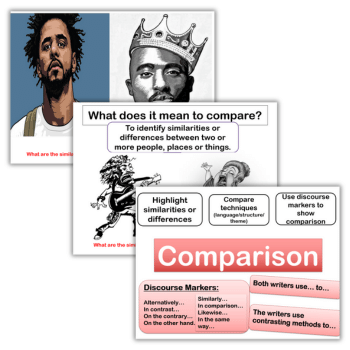Poetry comparison – How to write the perfect comparative essay

When it comes to poetry analysis, Phil Beadle knows what examiners want to see – and he’s here to make sure you can help every student can deliver it

- by Phil Beadle

Poetry comparison – or writing a comparative essay about two poems, seen or unseen – is what students will eventually be assessed on when they come to sit the poetry analysis part of their English Literature GCSE.
It makes sense, therefore, to get some early poetry comparison practice in. See what the assessment criteria will be asking for in preparation for the day the stakes are high.
The first door we must knock on is the one housing the crone of context. What the GCSE mark schemes will eventually ask for is a well constructed, conceptual response replete with oodles of subject terminology and a fairly deep mention of context.
It asks students to do this, however, in very little time. It also ignores the fact that contextual analysis in poetry – aside from the obvious modern/ancient dichotomy – is a rich brew that requires, firstly, a lot of contextual knowledge.
Also ignored is the fact that the biographical takes you away from the textual. Since the value in poetry analysis is the study of how words and form align to construct beauty or its antithesis, mention of context inevitably takes you into the realms of history. This is a whole other subject.
Poetry comparison example
Resources:
‘My Last Duchess’, by Robert Browning
‘Remains’, by Simon Armitage
Context – theme
So, my recommendation to students when constructing the first paragraph of a poetry comparison essay is, if appropriate, to make glancing reference to the titles. Only go so far as linking these to comparison of theme. The contextual is in the thematic.
On comparing theme, they should make explicit reference to the word ‘subtextual’. This flags to the examiner that this is an answer rich in apposite use of subject terminology quite early on. For example:
“The subtextual theme of ‘My Last Duchess’ is that sexual jealousy can cause the empowered (in this case titled) men – or, indeed, just men – to so lose their minds. They become murderous. Whereas the subtextual theme of ‘Remains’ links to the ambiguities of the title.
“As a noun, it links to the idea of the human remains of the looter around which the narrative revolves. As a verb, all that is left is memory.
“Both these poems linger around ideas of memory. Both narrators are tortured. But whereas the narrator in ‘Remains’ realises that he is stained by his actions, the narrator of ‘My Last Duchess’ is oblivious and has learned altogether nothing.”
Structure – rhyme
This is as far as we might want to go with context. Otherwise, we are addressing the poetic with its opposite and scribing a list of dates.
So, the next paragraph should examine structure. We do so by using rhyme scheme and form as a way of unlocking it. First of all, say what you see and, where possible, state the form:
“‘My Last Duchess’ is from Browning’s collection of ‘Dramatic Monologues’. It’s a substantial block of text with one person, the Duke, speaking. ‘Remains’ is seven quatrain stanzas and a couplet.”
Analysis of rhyme scheme
This is simple to do and gives students an opportunity to shovel a bit of subject terminology the examiners’ way. Generally, it is best to leave this unanalysed however. This is because analysis of rhyme scheme is much richer in terms of unlocking structure.
“The rhyme scheme in ‘My Last Duchess’ is in perfect couplets. On the other hand, ‘Remains’ is the epitome of deliberate irregularity.
“If one is to take this as a symbolic suggestion of the degree of order in both dramatic and moral worlds, one might conclude that the world of the former poem is ordered and correct, whereas that of the latter is chaotic and incongruent.
“There is an irony in the Duke speaking in perfect rhyme, being able to rhyme “munificence” and “pretence” and then suggesting he has no “Skill in speech”. This suggests him to be the liar he is.
“But the more interesting approach is in ‘Remains’: three out of four of the end words in stanza one, in which the looters raid the bank, are repeated in stanza six, when the incident is replayed in the narrator’s memory.
“The fact that only three of the four words -“out”, “bank”, “not” – are repeated suggests the decay of memory. Internal rhyme also plays a part in the pivot between action turning into memory. The fourth stanza features eye rhymes ”agony”, “by”, “body” before going into near perfect rhyme that carries on into the next stanza, “lorry”, “really”.
“But “really” is an add on, a coda to the phrase “End of story”. It suggests that the death of the looter should have been the finish of the event, but that there is an unpleasant coda. This is the fact that memory ‘remains’.”
You can get a lot from a poem through examining the rhyme in detail.
Metre – stress
From there, we go onto a fairly stunted form of metrical analysis; and we do this precisely because others avoid it.
I am not suggesting that students attempt analysis of trochees and anapests. After all, to our modern untrained ears, the differences between stressed and unstressed syllables can be unfathomable.
But where there is obvious metric change, we take this as a signal from the poet to pay special attention to this line (and to analyse it).
“Metrically, ‘My Last Duchess’ appears to be in tetrameter with the odd substitution, “I call”. This, again, might be taken to suggest the narrator’s level of control over his circumstances.
“The metre in ‘Remains’ is used to create specific effects. It is broadly irregular except in stanzas one, three and six (even, event, recall) where it goes into tetrameter.
“The substitutions on “Sleep” and “Dream”, however, give a jarring effect, an elongated stutter, a metric pause. This sets up the brief moment of peace before the nightmare of replayed events comes back to haunt him.”
Language – reflections
We do not go over the top with metrical analysis. Just one comparison is enough to let the examiner know we are on top of the brief.
“We do not go over the top with metrical analysis”
From there, we divert into the linguistic. Show the examiner that you can recognise the idea that the soundtrack of the poem is somehow a representation or mirror of the poem’s themes. One killer comparison is all we need:
“Ultimately, the distinction is between a narrator rich in self delusion and one haunted by self knowledge. Both are murderers, but one has no guilt over an action he considered before committing. The other took a rapid action that now haunts him.
“The difference in consideration is signalled by the punctuation. There is a difference between the time implied by the commas in “probably armed, possibly not” and the semi colons in “This grew; I gave commands; then all smiles stopped together”.
“It tells us much about their comparative level of ruthlessness and design at the moment of decision. There is also a distinction in maturity that is signalled by the howling childishness of the ‘oo’ sounds in “forsooth”, “choose” and “stoop” and the deadening emotional stutter of pain in the repetitive ‘n’ sounds in the penultimate line of ‘Remains’.”
And as for conclusions for your comparisons in poetry essay, don’t bother. We haven’t got the time, and they are always rubbish anyway.
Phil Beadle is a teacher and the author of several books. This includes Rules for Mavericks: A Manifesto for dissident creatives (Crown House). Check out our AQA English Literature Paper 1 revision resource.










